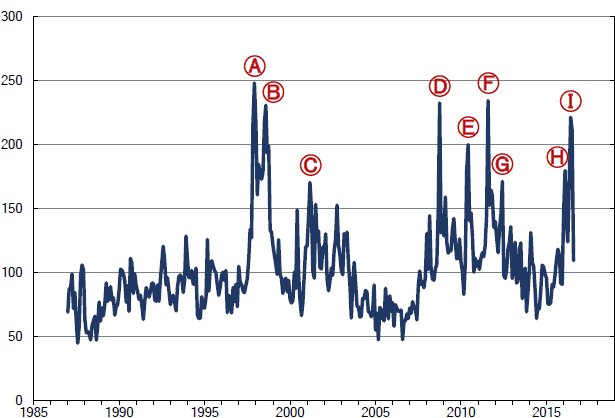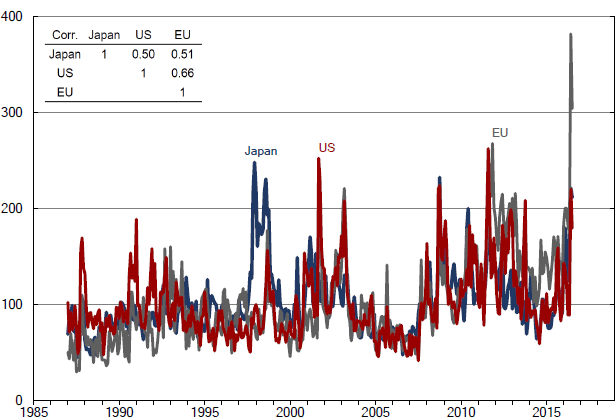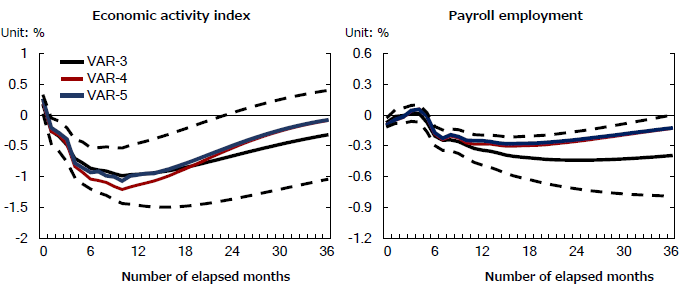Many corporate executives despise government policies with no clear direction as the transparency of the economic outlook gets compromised. This article examines how the level of economic transparency has been changing over the last 30 years as a result of government policies, and posits that the current level of economic uncertainty is reaching the level previously recorded immediately after major political or economic events. The economic uncertainty index for June 2016, based on newspaper articles, approached the level experienced after the 1997 Asian financial crisis, 1998 "Twisted Diet" period with different parties controlling the Upper and Lower Houses, 2008 collapse of Lehman Brothers, and 2011 debt-ceiling crisis in the United States. According to our recent research results, this level of increased economic uncertainty could reduce the nation's overall economic activities and employment by 1.2% and 0.1% respectively over the next 12 months. This scale is equivalent to one-third of the worst level seen in economic recessions over the last 20 years.
Quantifying the degree of uncertainty based on newspaper articles
Economic uncertainty attributable to government policies cannot be directly observed, and must be measured with proxy indicators that represent it indirectly.
The Economic Policy Uncertainty Project (EPU Project), launched by University of Chicago Professor Steven J. Davis, Stanford University Professor Nick Bloom, and others, developed an index based on newspaper articles to indicate the degree of monthly or daily economic uncertainty (Note 1).
Behind the approach of using newspaper articles lies the observation that, when household and corporate spending are exposed to a high level of economic uncertainty, newspapers tend to carry related articles at a substantially high frequency.
The monthly index in the United States, which began in January 1985, is compiled with month-by-month searches of 10 major newspapers including USA Today and Wall Street Journal for articles containing the terms "economic," "economy," "uncertain," "uncertainty" as well as policy-related terms such as "Congress," "deficit," "Federal Reserve," "legislation," "regulations" and "White House."
More specifically, for each newspaper, the number of articles containing these terms in a particular month is divided by the total number of articles carried in the applicable newspaper in the same month. The ratio data are then normalized so that the standard deviation for the period from January 1985 to December 2009 is set to one. Then, the 10 series of numbers normalized for each month are averaged. The index is obtained by adjusting the gained time series data so that the average for the period from January 1985 to December 2009 is set to 100.
Tasks remaining in the Japanese index
The project used the same method to compile indices for 16 countries and regions including Japan and Europe. For Japan, the monthly indices from June 1988 to April 2016 have been released.
However, the indexing process involved several issues. The first was the need to increase the number of newspapers from which to collect data. The Japanese index was based on articles carried in the Asahi and Yomiuri newspapers. Collecting data from a greater number of newspapers would reduce the effect of noise from individual newspapers' data series on the final index.
The second issue was the selection of terms used to search the database of articles for those concerning economic uncertainty. The monthly indices obtained were based on the Japanese word "keizai," which corresponds to "economic" and "economy," and the words "futomei" and "fukakujitsu" as the equivalents to "uncertain" and "uncertainty." However, the selection of these terms did not involve careful research on newspaper articles. There was a possibility that terms commonly used in articles may have been overlooked.
The third issue was the lack of indices specific to policy categories. For example, in the United States, the project prepared not only the overall index but also indices for 11 policy categories including fiscal policy, financial policy, regulatory policy, and trade policy. The availability of category-specific indices allows the examination of the types of policies that have a greater impact on economic uncertainty at any given time, or how the correlation between uncertainty and economic activities varies between different categories.
The joint research project among the EPU Project, the International Monetary Fund (IMF) Regional Office for Asia and the Pacific, and RIETI has addressed these issues as part of their research activities to substantially improve existing indices (Note 2). The following are the provisional outcome of such efforts for the overall index.
Characteristics of the new index
Figure 1 shows a new improved index, based on monthly data. The data sampling period was from January 1987 to August 2016, but the August index was based on data from the 1st to the 16th of the month. The greater the index figure is, the higher the degree of uncertainty becomes.

The new index is based on the number of articles that appeared in the morning and evening editions of Asahi, Mainichi, Yomiuri (editions published by the Tokyo head office for these three papers), and Nikkei newspapers (excluding articles in regional sections), containing 31 policy-related terms including "keizai (economy)," "keiki (economic conditions)," "futomei (unclear)," "fuan (concern)," "fukakujitsu (uncertain)," "fukakutei (unconfirmed)," "zeisei (taxation system)," "saishutsu (expenditures)," "koteki saimu (sovereign debt)," "nihon ginko (Bank of Japan)," "kisei (regulations)," and "kokkai (Diet)"(Note 3).
These terms have been selected after carefully examining some 1,300 articles featured in the Japanese and English editions of the Mainichi, Yomiuri, and Nikkei newspapers from January 1987 to March 2016.
The new index went higher following major political or economic events.
A) Asian financial crisis
B) Ruling party's defeat in the Upper House election causing the "Twisted Diet"; Russian crisis
C) Bank of Japan's introduction of quantitative easing policy
D) Lehman Brothers collapse
E) Ruling party's defeat in the Upper House election causing the "Twisted Diet"; European debt crisis
F) Confrontation between the U.S. Democrats and Republicans concerning the increase of the debt ceiling
G) Confrontation within the ruling Democratic Party of Japan concerning the proposed bill for comprehensive reform of social security and tax systems
H) Bank of Japan's introduction of negative interest rates
I) Japanese government's decision to delay the increase of the consumption tax rate; United Kingdom votes to leave the EU
More recently, the new index shot up in May and, in June, reached the level experienced after the 1997 Asian financial crisis, 1998 "Twisted Diet," 2008 collapse of Lehman Brothers, and 2011 debt-ceiling crisis in the United States. The index remained high in July, but has since come down to the late 2015 level this month.
Figure 2 compares the indices for Japan, United States, and Europe. The data sampling period is from January 1987 to July 2016. While the U.S. and European indices reached very high levels at the time of the 9/11 terrorist attacks in the United States in 2001 and the Iraq War in 2003, the Japanese index remained low at these times.

Figure 3 shows the economic activity index obtained by estimating the monthly vector auto regressive (VAR) model and the dynamic response of payroll employment, in order to examine the quantitative correlation between policy-induced economic uncertainty and the real economy. This is expressed as the impulse response function with a 65-point positive shock on the new index. Sixty-five points represent the size equivalent to the difference between the 2011-2012 average (when the index rose after the global financial crisis) and the 2005-2006 average (when the index was low before the global financial crisis).

When there is a shock, the nation's overall economic activities stagnate over a long period (left panel). The activities dip at most by 1.1% 10 months post-shock. In contrast, payroll employment responds negatively to the shock, but only mildly, over a long period (right panel).
Following a shock, the nation's overall economic activities drop by 0.8% over one year. Accordingly, the increase in economic uncertainty in Japan from May to June (approx. 100 points) is estimated to decrease the nation's overall economic activities over the next 12 months by 1.2% (= 0.8*100/65). It is also estimated to reduce payroll employment by 0.1%. These impacts are not very large, equivalent to one-third of the worst level seen in economic recession over the last 20 years.
Authors' note: The views expressed in this column are those of the authors and should not be attributed to the IMF, its Executive Board, or its management.

